American Optical Company
Scovill Mfg. Company
The Scovill & Adams Company
American Optical/Scovill Back Focus Tapering Bellows Field View Cameras - Chronology and Design
Back Focus Cone/Tapering Bellows Field View Cameras - Basic Design Elements:
A back focus field view camera is 1) a camera designed for field rather than studio work, 2) usually folding, 3) has a fixed front standard, usually with a rising panel on which the lens board (and lens) is mounted, 4)) has a rear standard, usually movable, to focus the image on a ground glass screen, and to hold the light sensitive photographic medium, and 5) has a platform, to which the front standard is fixed, and on which the rear standard slides or moves. An example is shown below, in which its basic parts have been identified.
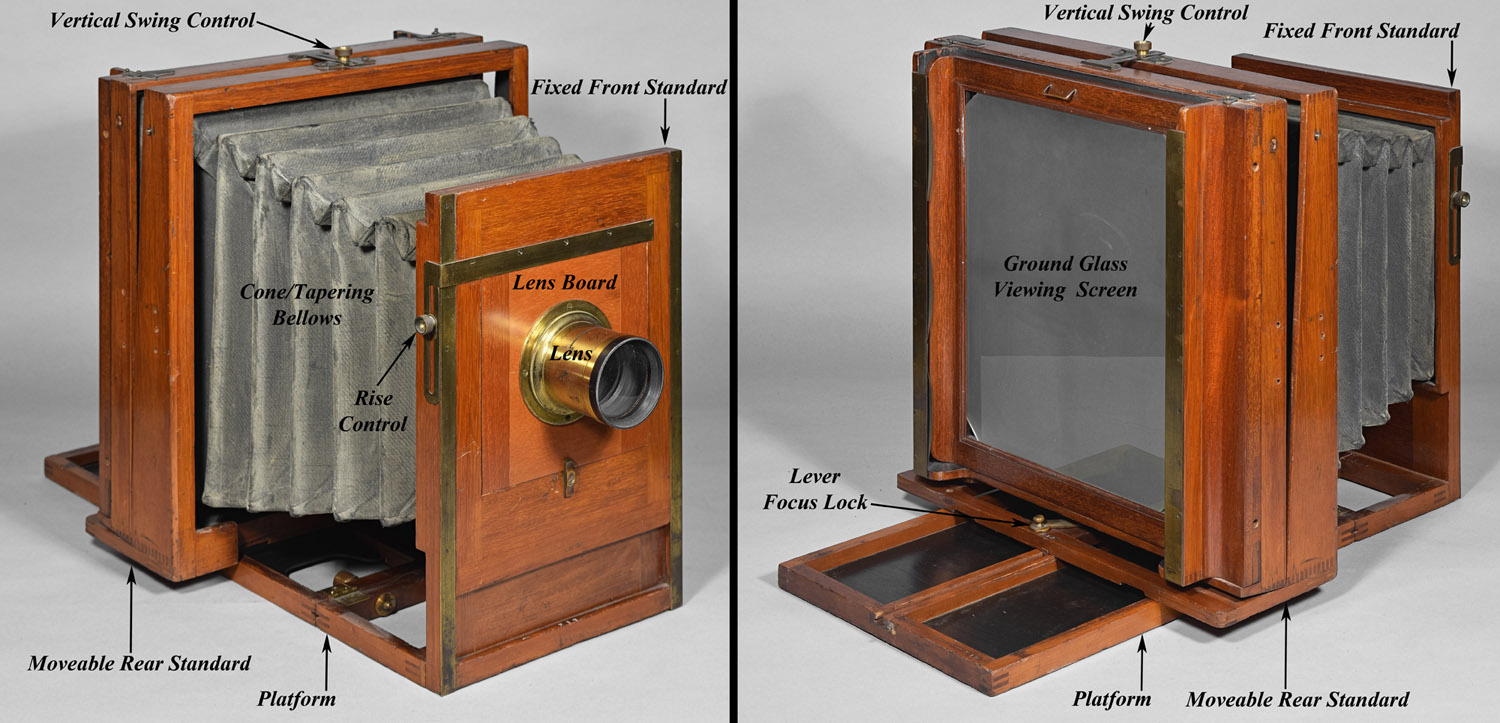
The back focus tapering bellows view camera has been a popular choice of design for photographers from the beginning of the craft for two reasons: because 1) the distance from the lens to the subject(s) during focusing does not change, the image perspective and cropping also does not change, and 2) when folded, the front standard can fit within the rear standard, making a very compact package for carrying, an advantage that often is worth the extra expense of a tapering bellows design relative to a non-tapering bellows design.
American Optical/Scovill Back Focus Tapering Bellows Field View Cameras - Introduction:
The American Optical Co. and Scovill Mfg. Co. made back focus cameras from their first entrance into camera manufacturing, as that design was prevalent at the time. They introduced their first cone or tapered bellows in Photographic Times, Vol. 3, June 1873, Scovill Mfg. Co. (New York, NY), p.83 as "Our New View Boxes". They used the term View Boxes to indicate field rather than studio cameras. From then until they merged with E. & H.T. Anthony & Co. in 1901, they continued to offer one or more models of back focus cone bellows view camera.
From 1873 though about 1882, the models were necessarily made for wet plate photography. Starting in about 1882, existing models were converted to the use of dry plates (sometimes by merely changing the plate holder). The relative simplicity of using commercially made dry plates made possible a hobby of amateur photography. Dry plate photography was, in turn, eclipsed by the greater simplicity of the Kodak ("You press the button, we do the rest"). the introduction of which caused the death of amateur dry plate photography within 20 years. But during that 20 years, the large numbers of dry plate hobbyists created a demand for various models of camera, sometimes better, more expensive, of complex or novel design or appearance, sometimes less expensive or easier to use. The demand fueled a period of patents and invention with which even multiple catalogs per year could not completely document.
Almost every manufacturer of cameras 1882-1900 produced at least one back focus tapering bellows field view camera model. Some, like American Optical/Scovill had a series of models which changed over time, and some manufactured contemporaneously.
Below are described the models produced prior to 1900 by just American Optical/Scovill of just the one form of view camera - back focus tapering bellows folding field camera.
American Optical/Scovill Back Focus Tapering Bellows
Field View
Cameras -
Wet Plate models:
As far as can be seen from the very few available
references from the wet plate era, the offerings of
Scovill Mfg. Co. and
its subsidiary, American Optical Co., consisted of two very similar
models. One was manufactured in the former factory of
Samuel Peck
& Co. in New Haven, CT, which Scovill Mfg. Co. had purchased in 1860.
The other was manufactured in the American Optical Co. factory in New
York City, which Scovill Mfg. Co. had purchased in 1867. The difference
between the models appears to have been finish and cost, as an 8x10
double swing model from the New Haven factory cost $38 in the 1884
catalog, whereas an 8x10 double swing model from American Optical cost
$52 in the same 1884 catalog (on a different page).
Throughout the remainder of the 19th century, Scovill appears to have
continued to produce inexpensive cameras out of the New Haven factory,
and the highest quality cameras out of the New York City factory.
Scovill New or Improved View Camera Boxes / New Haven Compact View Camera (c.1873-c.1884):
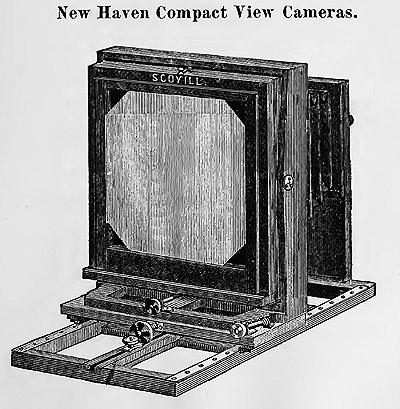 This is the least expensive of the two
similar wet plate design back focus tapering bellows field view camera models offered by
Scovill or American Optical. In the 1884 catalog
(Descriptive Catalogue and Price List of the Photographic Apparatus
Manufactured by the American Optical Co., Scovill Mfg. Co.,
proprietors and managers (New York, NY), Sept. 1884, p.75), this
model was in a
section introduced as Scovill New
Haven Factory, and most of the
cameras advertised in this section have "New Haven" in their name.
The introduction to the section states that the New Haven factory has
been enlarged and reorganized. However, this camera model (having
the same configuration as evidenced by its accompanying engraving, was
first introduced in 1873 in Photographic Times 3,
Scovill Mfg. Co. (New York, NY), June, 1873,
p. 83, where it was referred to as the
New or Improved View Camera Boxes.
This leaves a question of whether this model was always made in New
Haven (it could have been), or was it made in New York City for a time until the New Haven factory
was enlarged and reorganized. Regardless, this model is seen to
have probably remained the same through the end of the wet plate era and
into the dry plate era. What is certain is that, for at least one
moment in 1884, Scovill wished to make
clear which cameras were made in the New Haven factory and which cameras
were made in the New York City factory.
This is the least expensive of the two
similar wet plate design back focus tapering bellows field view camera models offered by
Scovill or American Optical. In the 1884 catalog
(Descriptive Catalogue and Price List of the Photographic Apparatus
Manufactured by the American Optical Co., Scovill Mfg. Co.,
proprietors and managers (New York, NY), Sept. 1884, p.75), this
model was in a
section introduced as Scovill New
Haven Factory, and most of the
cameras advertised in this section have "New Haven" in their name.
The introduction to the section states that the New Haven factory has
been enlarged and reorganized. However, this camera model (having
the same configuration as evidenced by its accompanying engraving, was
first introduced in 1873 in Photographic Times 3,
Scovill Mfg. Co. (New York, NY), June, 1873,
p. 83, where it was referred to as the
New or Improved View Camera Boxes.
This leaves a question of whether this model was always made in New
Haven (it could have been), or was it made in New York City for a time until the New Haven factory
was enlarged and reorganized. Regardless, this model is seen to
have probably remained the same through the end of the wet plate era and
into the dry plate era. What is certain is that, for at least one
moment in 1884, Scovill wished to make
clear which cameras were made in the New Haven factory and which cameras
were made in the New York City factory.
This model has swing hardware similar to that found on studio cameras, that is, two thumbscrews (one for vertical swing and one for horizontal swing) that operate separate short rack and pinions for each swing. Its focus lock is a fine-focus-screw type featured in a John Stock 1865 patent (this may not be the patent for the fine focus screw, since it is only referred to rather than being an essential part of the patent).
American Optical Cone View Camera (Model No.'s 51-58) - (c.1873-c.1884):
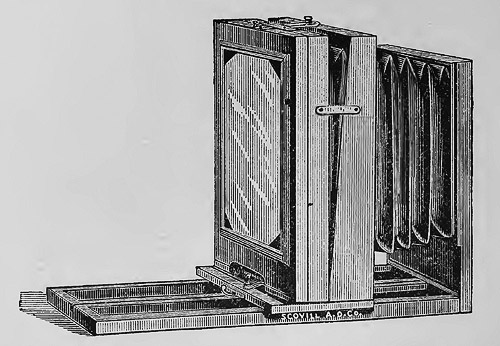 This is the more expensive and
immaculately finished of the two similar wet plate design back focus
tapering bellows models offered by Scovill or
American Optical.
This one is in the part of the 1884 catalog preceded by: "Photographic
Apparatus Manufactured by the American Optical Co., New York", so
undoubtedly was made in the New York City factory. By the 1884
engraving, we see that its hardware is of the type patented by Mathias
Flammang in 1881 (US 246,738), consisting of one lever in the center of
the rear standard to lock the focus, and a second lever below it to lock
the horizontal swing in a neutral position. Apparently, it was
thought that while the swing was not neutral, it did not need locking.
This is the more expensive and
immaculately finished of the two similar wet plate design back focus
tapering bellows models offered by Scovill or
American Optical.
This one is in the part of the 1884 catalog preceded by: "Photographic
Apparatus Manufactured by the American Optical Co., New York", so
undoubtedly was made in the New York City factory. By the 1884
engraving, we see that its hardware is of the type patented by Mathias
Flammang in 1881 (US 246,738), consisting of one lever in the center of
the rear standard to lock the focus, and a second lever below it to lock
the horizontal swing in a neutral position. Apparently, it was
thought that while the swing was not neutral, it did not need locking.
From 1873, when Scovill introduced The New View having its tapered bellows, through 1881, it would be logical for the American Optical New York City factory to make a tapered bellows back focus view. It would not have the patent hardware of the 1881 patent, but might have appeared similar to the camera thought to be the American Optical Co. View Camera Boxes Model Number 1 (Order No.'s 1-7, 11x14 example view f) except having tapered bellows.
American Optical/Scovill Back Focus Tapering Bellows View
Cameras -
Dry Plate Models:
During the heyday
of amateur dry glass plate photography, approximately 1883-1900,
the Scovill Companies (that is, the
American Optical Co. the
Scovill Mfg. Co. and
The Scovill & Adams Co.) produced
view cameras having a wide variety of design as well as a wide range of
cost. One of the most popular camera types was a basic, robust, back focus
camera having tapering (sometimes called cone) bellows for compact folding.
Manufacturers
other than the
Scovill Companies
had their version(s) of this basic design, too:
E. &
H.T. Anthony & Co.
had its many variations of
Novel Cameras
(Variations
1.0,
1.5,
2.0
and
3.0),
Fairy Novel Cameras
(Variations
1.0,
1.1,
2.0
and
2.1),
Novelette Cameras
(Variations
0.5,
1.0, and
2.0),
Duplex Novelette,
Front Focus
Novelette and
Klauber
Novel Camera, the
Blair Camera Co. had its
Standard
Camera and
Combination Reversible Back Cameras
(Variations
1.0,
2.0,
2.5
and
3.0),
G. Gennert had its
Burlington/Nancy Hanks Camera,
the
Rochester Camera Mfg. Co. (and
Rochester Camera Co.,
Rochester Camera & Supply and
Rochester Optical Co.) had its
Favorite View Camera
(Variations
1.0, 2.0 and
3.0),
and J.A. Anderson had what I have
called its
Pre-New View Box
and
New View Box. The purpose of
this note is to compare the dry plate back focus tapering bellows models
produced by the
Scovill Companies. Their top-of-the-line model of this
type was the Flammang's Revolving
Back Camera Back Focus,(Variations
1.0,
2.0,
2.1,
2.2
and
3.0),
featuring a way to quickly change from horizontal to vertical format by
means turning the ground glass frame/plate holder insert slot around 360°
on a circular brass track. This design was hardly basic, although
it was robust, and it was expensive. For a lower priced option the
Scovill companies had the Acme
View Camera (variations shown
below) and later, the Landscape
Reversible View Camera
. These camera models, and their many variations, are compared
below. The variations are my
invention in an attempt to systematize a confusing mix of very similar
designs of view camera, in the same way that botanists and zoologists
have systematized species of plants and animals. Each variation
generally represents a change of design that was adopted by a company or
factory as an innovation or improvement (or a saving in manufacturing
cost). As such, only one variation would be expected to have been
produced at a given time, if we could only figure out that timing for
each variation.
Flammang's Revolving Back View
Camera Back Focus Model (1883-c.1896) - Variations:
There are currently
at least five
variations of Flammang's Revolving Back View Camera Back Focus model,
and one counterfeit copy. The differences between the
variations are due to 1) push-pull or rack and pinion focus, 2) whether
the vertical (forward-back) swing is hinged at the bottom or at the
middle of the rear standard, and 3) lacquered brass or nickel-plated
brass hardware:
Flammang's Revolving-Back
View Camera Back Focus
Variation 1.0:
1) push-pull focus having a lever in the rear to secure it, 2) vertical
swing hinged at the bottom of the rear standard (as in catalog
engravings) and 3) lacquered, draw-filed brass hardware. This is
the camera configuration as depicted in the engravings in
American Optical/Scovill
catalogs and other advertisements.
Flammang's Revolving-Back View Camera Back Focus
Variation 2.0:
1) push-pull focus having a lever
in the rear to secure it, 2) vertical swing hinged in the middle of
the rear standard, and 3) lacquered, draw-filed brass hardware.
Flammang's Revolving-Back View Camera Back Focus
Variation 2.1:
same as Variation 2.0
(push-pull focus, swing hinged in the middle), except having a device at
the rear standard that, when pushed, allows horizontal swing. The
example is also later than the Variation
2 examples, in that it was made when
American Optical was
owned by The Scovill & Adams Co. (after 1889)
Flammang's Revolving-Back View Camera Back Focus
Variation 2.2:
same as Variation 2.0
(push-pull focus, swing hinged in the middle), except for 3)
nickel-plated, polished brass hardware.
Flammang's Revolving-Back View Camera Back Focus
Variation 3.0:
1) rack and pinion focus, 2)
vertical swing hinged in the middle, and 3) lacquered, draw-filed brass
hardware. Another camera of interest to Flammang's Revolving Back Camera
design: Acme
Reversible Back View Box / Back Focus Cone View Camera Model
(c.1878-c.1890) -
Variations:
During the
Scovill Mfg.
Co.
era (<1889), sometimes, this model's labels read: "American Optical Co., -
Scovill Mfg. Co., N.Y. Prop't'rs" but sometimes they read simply
"Scovill Mfg. Co., N.Y.". During the
Scovill & Adams Co.
era
(1889-1901), the labels merely read: "The Scovill & Adams Co. - New
York". Since the high quality construction and appearance of
the camera is constant, regardless of era, it is likely that the camera
was always manufactured in the New York City factory of There are three variations and one variation that
has a different name (all are variations in the
way plate holders are inserted into the back):
Acme
Reversible Back View Camera Variation 1: This is the camera as shown
in the advertising, including a ~2" thick removable, reversible back.
To take a photograph, the back's ground glass frame is slid out and
replaced by the plate holder.
Acme
Reversible Back View Camera Variation 2: This variation also has a removable,
reversible back, but it also has an interior ground glass frame that is
released via a lever. The plate holder would then be
inserted into the hole vacated by the ground glass frame. This
variation is assumed to be c.1885, since this same back is pictured in
1885 advertising for the
American Optical Co. Ripley Camera. It may, therefore, be the first variation of the
Acme chronologically.
But why then would the advertising engraving show the
Variation 1. It
could be that
Variation 2 was a
very short lived, expensive to produce version of the
Acme, the
Variation 1 being the original
version made before
Variation 2,
but also made after
Variation 2
well into the
Scovill & Adams Co.
era.
Acme
Reversible Back View Camera Variation 3: This variation has yet a third
variation of removable, reversible back, which, in this case, has spring
back that, unlike
Variation 1
and Variation 2,
does not have to be removed to insert a plate holder - a very handy
improvement. It has a complex set of four springs that can be set
open, allowing the plate holder to be easily slid under it, then
released to tightly hold the plate holder in place. This type of
back is also seen in other high end
American Optical
cameras of the
Scovill & Adams Co.
era: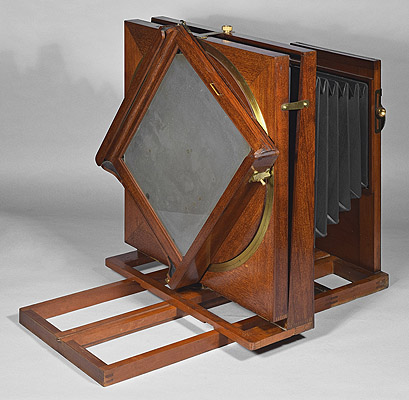 The revolving back was patented by Mathias Flammang 21 Aug. 1883 (US
283,589), one of many patents granted to Flammang while working for
Scovill Mfg. Co. The revolving back could be had either on a back
focus or front focus design. It is one of the longest lived
Scovill designs, being introduced in 1883 (The Photographic Times
and American Photographer, Vol. XIII, No. 149, Scovill Mfg. Co.,
May 1883, p. 205 ), and carried in catalogs and other advertising
literature until approximately 1898.
The revolving back was patented by Mathias Flammang 21 Aug. 1883 (US
283,589), one of many patents granted to Flammang while working for
Scovill Mfg. Co. The revolving back could be had either on a back
focus or front focus design. It is one of the longest lived
Scovill designs, being introduced in 1883 (The Photographic Times
and American Photographer, Vol. XIII, No. 149, Scovill Mfg. Co.,
May 1883, p. 205 ), and carried in catalogs and other advertising
literature until approximately 1898.
Counterfeit Flammang's Revolving Back
View Camera Back Focus Variation 3.0:, a camera which superficially looks
like the genuine American Optical
Flammang's Revolving Back View Camera Back Focus Variation 3.0, but, in
detail, can be seen to have almost every detail and measurement slightly
different than a genuine Variation
3.0. 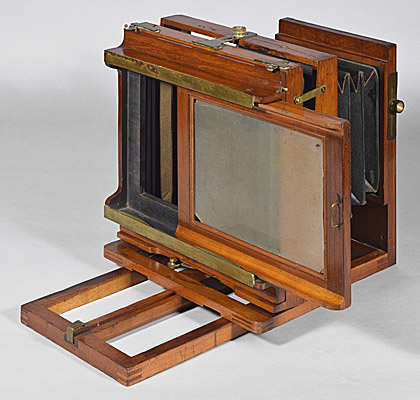 The Acme View Camera
can be found in catalogs and advertising approximately from 1884 through
1888, although there was a similar
Scovill tapered bellows view camera
during the wet plate era (see
American Optical New Camera Box). It was referred to
as one of a number of names: Back Focus Cone View Camera,
Acme
View Camera,
Reversible Back View Camera.
Despite its workmanlike design, it was highly finished in the
American Optical
way, showing French polish on the wood, draw file finish on the
hardware, and screw slots that were laboriously aligned along the length
of each brass part then filed down perfectly even with the part.
The Acme View Camera
can be found in catalogs and advertising approximately from 1884 through
1888, although there was a similar
Scovill tapered bellows view camera
during the wet plate era (see
American Optical New Camera Box). It was referred to
as one of a number of names: Back Focus Cone View Camera,
Acme
View Camera,
Reversible Back View Camera.
Despite its workmanlike design, it was highly finished in the
American Optical
way, showing French polish on the wood, draw file finish on the
hardware, and screw slots that were laboriously aligned along the length
of each brass part then filed down perfectly even with the part.
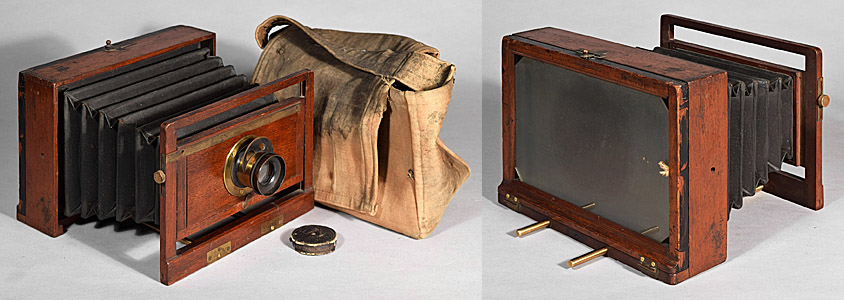
Tourist Pocket Outfit (1883-c.1891):
One of the rarest of American Optical/Scovill cameras, the
Tourist Pocket Outfit had a long run of advertisement, but apparently few sales, judging from the number of such cameras extant (seemingly only the one shown here). The design of the Tourist Pocket Outfit was patented by the ubiquitous Mathias Flammang on Jan. 30, 1883. The design consists of a front and back standard mounted to nickel-plated brass rails. The standards are separated from the rails for storage. Despite the canvas case supplied upon purchase, the loss of the rails was perhaps inevitable for the camera in the image. The Tourist Pocket Outfit breaks down into a very compact a 6x9x3" for a 5x8" format camera. Landscape Reversible View Camera Model (c.1895-c.1900) - Variations:
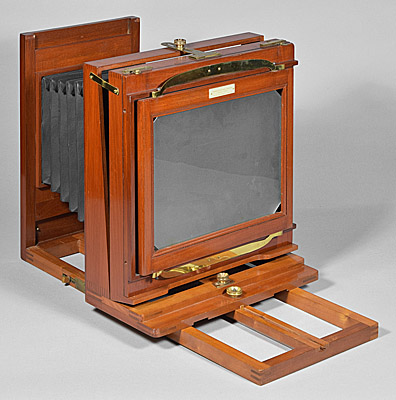 The
Acme and the
Landscape cameras were never advertised at the same time.
In fact there is a gap of at least two years between the apparent
abandonment of the
Acme and
the start of the
Landscape.
Neither the Acme nor the
Landscape view cameras were
advertised in the Scovill & Adams
Co. catalogs for
January 1889,
March 1889,
March 1890,
June 1890,
April 1891,
June 1891, and
January 1892 (but no examples of catalogs from late 1892 through
early 1895 have been observed as yet) or in the almanacs for 1892, 1893,
1894 and 1895. However, it is also entirely possible that
Acme-type
cameras were still being manufactured 1892-1894, despite the lack of
advertising seen so far. During this
Acme-Landscape
gap, the only rear focus, cone bellows view camera advertised was the
Flammang's Patent
Revolving Back Camera Back Focus (a camera that is,
other than its revolving back, identical to the
Acme).
The
Acme and the
Landscape cameras were never advertised at the same time.
In fact there is a gap of at least two years between the apparent
abandonment of the
Acme and
the start of the
Landscape.
Neither the Acme nor the
Landscape view cameras were
advertised in the Scovill & Adams
Co. catalogs for
January 1889,
March 1889,
March 1890,
June 1890,
April 1891,
June 1891, and
January 1892 (but no examples of catalogs from late 1892 through
early 1895 have been observed as yet) or in the almanacs for 1892, 1893,
1894 and 1895. However, it is also entirely possible that
Acme-type
cameras were still being manufactured 1892-1894, despite the lack of
advertising seen so far. During this
Acme-Landscape
gap, the only rear focus, cone bellows view camera advertised was the
Flammang's Patent
Revolving Back Camera Back Focus (a camera that is,
other than its revolving back, identical to the
Acme).
To second-guess the
Scovill & Adams
executives, the
Flammang's
Patent Revolving Back Camera
would appear to be a very expensive camera to be the only offering of
this type. Remember that a rear-focus camera is the only viable
option for very large (usually professional) cameras, while the cone
bellows reduces the weight of the very same large cameras. It is
as if
Scovill & Adams
was abandoning or at least reducing the options
for the professional photographer. Whatever the reason for
discontinuing the
Acme, it
would seem that the executives soon recognized that a camera of lower
cost than that of the
Flammang's
was needed - by the 1896 catalog, the
Flammang's Revolving Back cameras have disappeared and the
Landscape Reversible Back Camera has appeared.
One
major design difference between the
Landscape Reversible View and the
Acme Reversible View
and the
Flammang's Revolving Back View is that it has a
simple, two spring, spring back arrangement - a design based on Thomas
Blair's Sep. 2, 1884 patent, used on cameras of almost all plate or film
view cameras made after 1901 (around the time the patent expired), and
still used today. Ads for the
Landscape Camera always show the
thinner and modern style (~ ½" thick) removable and reversible back,
just as
Acme
ads always show their thick (more than 1" thick) back. A second new feature
is a thick, all-wood construction front standard; the rising panel fits
into vertical slots in the standard sides. The rising panel is
quite recessed behind the surface of the front standard, whereas the
Acme
and
Flammang's Revolving Back
rise panels are even with the supporting sides of the
standard. The
rise locking mechanism is a spring-loaded button on the upper right side
of the front standard, which, when pushed, disengages a saw-tooth shaped
strip of steel.. In the older
Acme
and
Flammang's Revolving Back
cameras, the rising panels fit into slots in the standard sides, but
panel is held in by full-height brass strips; the rising panel is
controlled via a thumbscrew.
Landscape Reversible View Camera Variation 1: This variation has a push-pull focus locked with a thumbscrew in the middle of the base of the rear standard. Its vertical swing is push-pull, hinged at the bottom of the rear standard and controlled/locked by a slotted plate and thumbscrew on the top middle of the rear standard. Its horizontal swing is push-pull, locked by a thumbscrew just in front of the focus-locking thumbscrew. The folding platform is made rigid using the familiar Flammang's patent rod and cylinder device used on so many Scovill products. The hardware is polished and lacquered brass.
Another camera of interest to Landscape Camera design:
Landscape
Reversible View Camera
Variation 2:
This variation, while retaining the same essential design as
Variation
1, has quite a number of
differences: 1)the focus is rack and pinion rather than push-pull;
2) the vertical swing is hinged at the bottom, but controlled/locked by
a slotted plate and thumbscrew on the lower right side of the rear
standard (very similar to a number of
Scovill
products, the most common of which is the
Scovill Waterbury View Variation 2);
3)the example has no horizontal swing, 4) the folding platform is
made rigid with a simple thumbscrew and threaded plate rather than the
patented rod and cylinder device (amazing), and 5) the hardware is
nickel-plated rather than lacquered brass.
Back to American Optical
Co. / Scovill Mfg. Co. (alphabetical)
